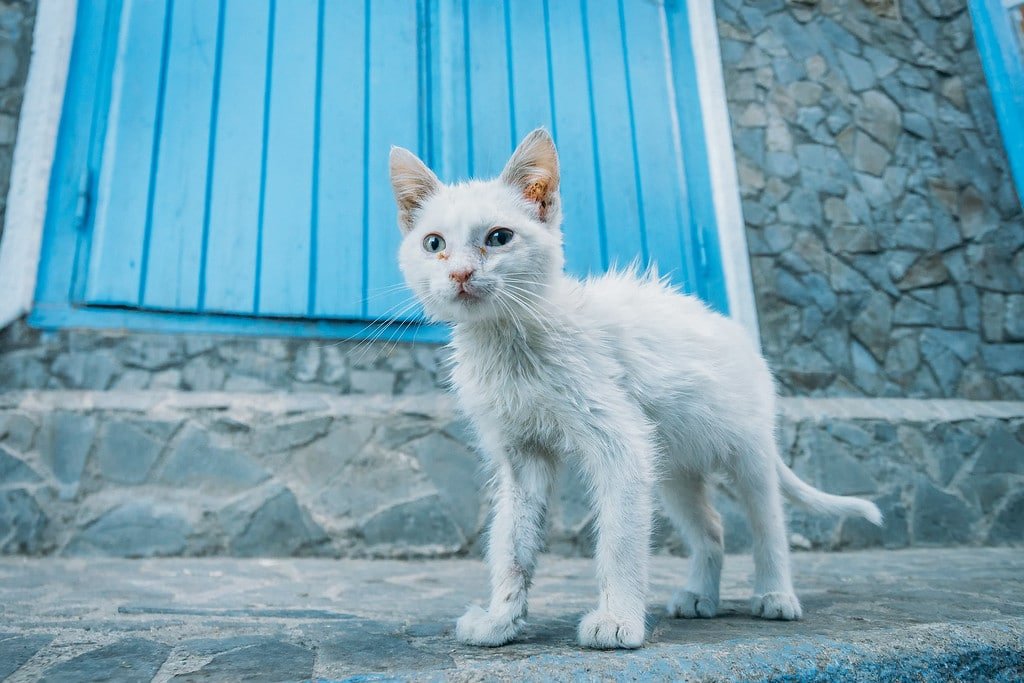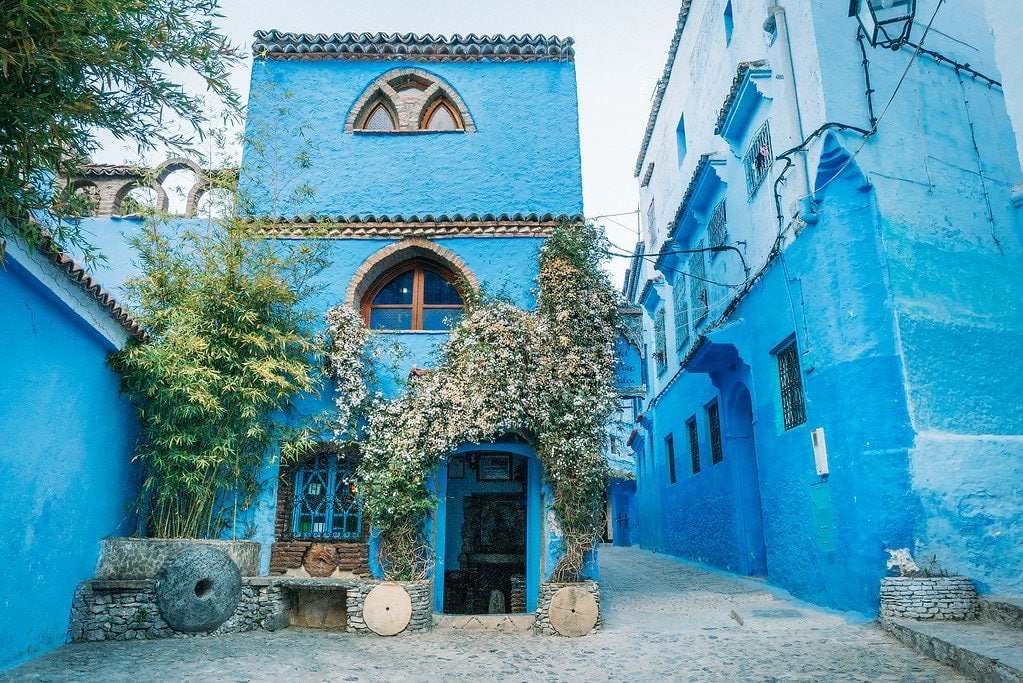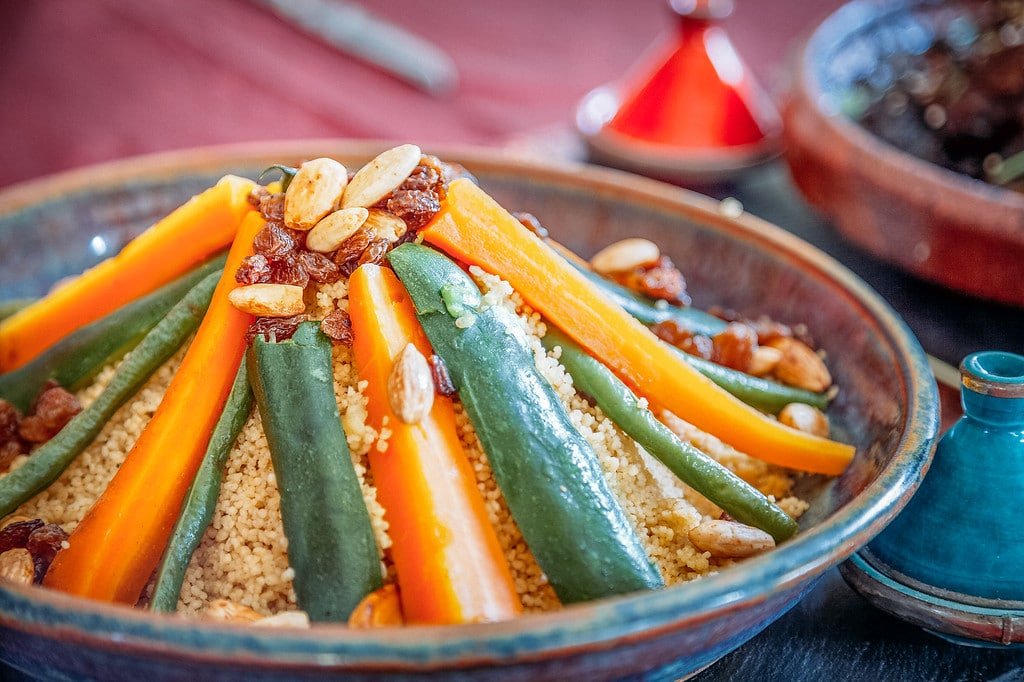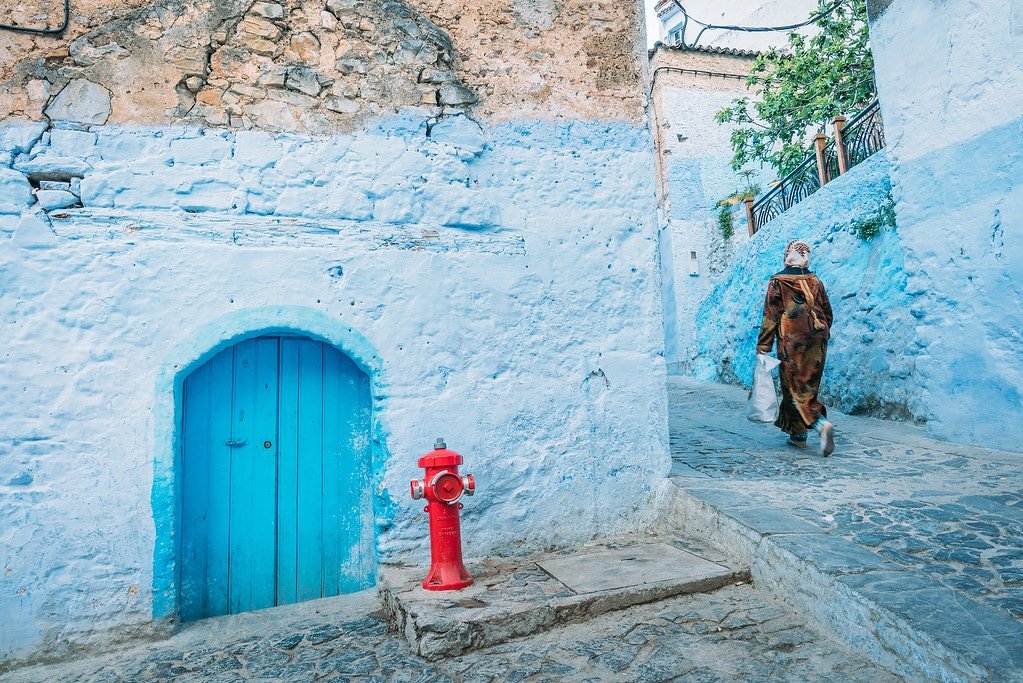
Exploring Chefchaouen in Morocco
Chefchaouen, Morocco
Welcome to Chefchaouen, the blue city of Morocco. It’s famous for all the houses and shops painted different shades of blue. A magical place to get lost in!
The sun beats down mercilessly, setting every color around me ablaze – and since everything is blue, I feel like I’m walking in a mythical sky kingdom.
But this is no myth, it’s Chefchaouen. Located in Northern Morocco, the city’s signature color is a variety of calming shades of blue that lower your blood pressure in seconds.
Known as Morocco’s “blue pearl” or “blue city”, the buildings in Chefchaouen are painted using a talc or chalk-based paint that looks so beguiling.
Exploring a labyrinth of narrow blue alleyways smelling of spice, incense, flowers, and fresh oranges — was one of the highlights of my journey to Morocco. Plus it’s a photographer’s dream!
Anna and I rented a car in Morocco for a two-week road trip through the country, including a few nights in the blue city.
Here are our tips and suggestions for fun things to do in Chefchaouen!

Our Journey to Chefchaouen was Awesome!

A Jewish Tradition of Blue Paint
Why Is Chefchaouen Blue?
Some will tell you that it’s a symbol of Jewish solidarity. In the 1930s, a sizeable population of Jewish refugees arrived in Chefchaouen, fleeing Nazi persecution and the growing threat of war.
The blue is meant to represent peace, safety and the power of heaven. In this version of the story, blue walls rapidly spread outward from the city’s Jewish quarter, until the entire city was aglow.
others would say (that’s Arabic for “nonsense”).
They’ll say the tradition of painting walls blue is Jewish, certainly, but goes back to the time of the city’s founding, in the 15th Century, when it was built around a fortress used to defend inhabitants against Portuguese invaders.
At this time, local Moroccans lived alongside Jews and Moriscos (former Muslims who had converted to Christianity) for a century or more.

Chefchaouen View from the Spanish Mosque Trail

Early Morning Calm in the Blue City
Exploring The Blue City
The narrow streets of Chefchaouen (or , as the locals call it) make no attempt to soften the impact of the hillside the city is built on. In some cases, stone steps march straight up the slope, giving your legs a good workout.
But when the streets open into public squares, look above the city, towards the nearby Riff mountains.
The mountains above the city give the appearance of two horns – and it’s believed that this is where the name Chefchaouen comes from (literally meaning “watch the horns” in a local dialect).
But the rest of the time, keep looking around you. This is a jaw-droppingly beautiful city! It transports you into a different world.
Best Things To Do In Chefchaouen

Go Shopping in the Medina
Get Lost In The Streets
This is why most travelers seek out Chefchaouen, to wander aimlessly through the narrow streets & alleys, painted in an endless array of blue — turquoise, powder blue, celeste, robin’s-egg, indigo, cyan, periwinkle.
Go shopping for colorful blankets or lamps in the souks hidden throughout the medina. Marvel at the variety of beautiful doorways and detailed tile work that decorate each residence.
Sit down at a street cafe, order a steaming glass of mint tea, and watch locals dressed in robes go about their daily life. Soak it all in — the whole Moroccan experience.

Get Your Kitty Fix in Chefchaouen
Go Cat Spotting
If you’re a cat person like me, you’re going to love Chefchaouen. It’s a cat city for sure — a bit like Istanbul. Locals feed them, however they generally live outside in the street as strays.
You’ll find cats in alleys, cats on the stairs, and cats in the souks. Cats will be roaming through restaurants and on terraces. They’re hiding in trees and bushes, and stretched out on sidewalks.
If you want to get a cat’s attention in Morocco, try hissing. It’s a great way to get them to pose for photos! Meow.
READ MORE: Exploring Morocco With Kids

Rock The Kasbah
Visit The Kasbah Fortress Museum
Make sure to visit the large 15th century Kasbah fortress and dungeon located in Chefchaouen’s main square — Place Outa el Hammam. It’s pretty easy to find this red-walled structure among all the blue buildings.
Built in 1471 by Mulay Ali Ben Mussa Ben Rached, the Kasbah features a beautiful garden and small ethnographic museum. Climb the towers inside for some great views of the city and the Grand Mosque.
The Kasbah was built in the Andalusian-Maghrebian style to defend Chefchaouen from attacks by the Portuguese and Spanish. Entry only costs €1 Euro! It’s totally worth a quick visit.

Getting Lost in Chefchaouen
Spend The Night In A Riad
“Riad” comes from the Arabic word for “garden”, and it’s referring to the space in the centre of these traditional Moroccan guest-houses, open to the sky, usually with a water fountain.
Most rooms in a riad point inwards towards this space, the symbolic heart of the home – and when you open your door first thing in the morning to find sunlight streaming down into the building.
The distant noises of Morocco will filter down through the hole in the ceiling. You’ll hear movement, the clank of morning tea being prepared, the Arabic call to prayer, and the rhythms of life outside. It’s all extremely relaxing.

The Horns Above Chefchaouen
Hike To The Spanish Mosque
There’s an old Spanish Mosque perched on a hilltop overlooking the blue city, built by the Spanish in the 1920’s. The mile-long hike passes by prickly pear and agave cacti — with wonderful views of Chefchaouen at the top.
Because the mosque is kind of abandoned, non-muslims are allowed to go inside and take a look. Make sure to bring water though, because on a sunny day it gets hot up there.
The trail to the mosque crosses the Ras el’Ma river, where you’ll see local women doing laundry the traditional way in cold mountain water. The hike up takes about 45 minutes one-way.

The City of Blue
Visit A Hammam
With a cleaning ritual that hasn’t changed for centuries, a visit to the hammam will leave you steamed, sweated, pummelled and scrubbed until you feel like every inch of your skin has been upgraded.
The main public hammam is across the square from the main mosque, Jama’a Kabir, and there are different attendance times for men and women.
You will also have to go shopping first for your own plastic sandals, soap, shower scrub and towel. The hammam experience is an integral part of life in Morocco!

Morocco’s Riff Mountains
Kif Field-Trip
The blue city of Chefchaouen has a long history of hippie-culture and the production of hashish — the most basic and traditional form of marijuana THC concentrate. Morocco is the world’s top supplier.
You might be offered a farm tour, where they drive you outside the city to the marijuana fields and demonstrate how they produce hash from , THC crystals extracted from the plant.
Just be wary… it is illegal to produce, trade, and smoke hash in Morocco, even in a place like Chefchaouen. Always remember that if you’re spotted, you could get arrested. Or blackmailed by the police for money.

Beautiful Cascades d’Akchour
Cascades d’Akchour Waterfalls
Cascades d’Akchour is a trail that leads to a pair of waterfalls in the Rif Mountains. You’ll need a taxi to get to the trailhead, and sturdy shoes for this 2-3 hour hike.
The trail is full of lush green vegetation, an interesting natural stone bridge called “God’s Bridge”, and a beautiful swimming hole with a waterfall as your reward at the end.
You’ll find makeshift “cafes” along the way, which serve Moroccan food and tea during this long, and somewhat steep hike. It’s nice, but a little touristy.

Vegetable Couscous was Delicious!
Eat Tasty Moroccan Food
One of the top reasons anyone should travel to Morocco is the amazing food, and you can find all your favorites in the Blue City. Stuff yourself on kefta (lamb meatballs), tajines (slow cooked stews in clay pots) and mountains of couscous.
Oranges and orange juice is a big deal in Morocco — and super delicious. A freshly squeezed glass will only set you back about 4 Dirhams ($0.40 USD). I couldn’t get enough!
Hot mint tea in Morocco is a sign of hospitality, friendship and tradition. It’s one of the most delicious treats you’ll find in the whole country, with a rich flavor you’ll struggle to find elsewhere.

Traditional Pastel Paints

Steep Cobblestone Streets
Getting To Chefchaouen
Chefchaouen is built on the edge of the Rif mountain range in the far north – and the only way there is by road, winding up a rocky landscape that’s surprisingly lush and green in the summer.
Renting Cars In Morocco
The best site to book a car is Discover Cars. They search both local and international car rental companies to help you find the best possible price. This is the easiest way to find a car rental in Morocco.
Driving in Morocco can be a bit crazy sometimes, but it’s a relatively straightforward journey of 115 km (about 2 hours of driving) from Tangier. I recommend using a parking garage, then exploring the old city on foot.
Traveling By Bus
The cheapest way to get to Chfchaouen is by bus. There are multiple buses per day from cities like Fez, Tetouan, Casablanca, Rabat, Tangier and Ceuta. The main bus company for tourists is CTM.
From Tangier, visit Gate Routiere (Place Al Jamia Al Arabia) and look for the next bus – there’s usually at least two running per day, with one departing at noon. The fare to Chefchaouen is 45 Dirham ($5 USD).
Traveling By Taxi
Morocco is full of unauthorized or semi-legit taxis driven by people who have one aim in life: to get as much money out of tourists as possible.
The standard price of a one-way trip in a private taxi from Tangier to Chefchaouen should be in the range of 300 – 500 Dirhams ($31 – $52 USD).
From Marrakesh On The Train
Take the night train from Marrakesh to Tangier, then continue to Chefchaouen by bus or taxi. The train leaves Marrakesh at 9:00 pm and arrives in Tangier at 7:25 am. There are sleeper cabins available.
Source: Destination Africa - expertvagabond.com


